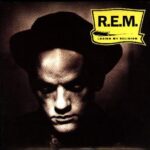 When R.E.M. released “Losing My Religion” in 1991, the song instantly redefined what alternative rock could sound like. At a time when the genre was still finding its identity — wedged between post-punk introspection and the grunge explosion waiting just around the corner — this Athens, Georgia band delivered a haunting, emotional anthem that didn’t rely on distortion, volume, or bravado. Instead, it centered around a mandolin riff. It shouldn’t have worked, but it did — spectacularly. “Losing My Religion” became a global hit, winning two Grammy Awards and turning R.E.M. from college rock cult heroes into mainstream icons. The song’s mixture of southern melancholy, spiritual ambiguity, and pop craftsmanship made it one of the defining singles of the early ’90s, capturing an entire generation’s quiet desperation in under five minutes.
When R.E.M. released “Losing My Religion” in 1991, the song instantly redefined what alternative rock could sound like. At a time when the genre was still finding its identity — wedged between post-punk introspection and the grunge explosion waiting just around the corner — this Athens, Georgia band delivered a haunting, emotional anthem that didn’t rely on distortion, volume, or bravado. Instead, it centered around a mandolin riff. It shouldn’t have worked, but it did — spectacularly. “Losing My Religion” became a global hit, winning two Grammy Awards and turning R.E.M. from college rock cult heroes into mainstream icons. The song’s mixture of southern melancholy, spiritual ambiguity, and pop craftsmanship made it one of the defining singles of the early ’90s, capturing an entire generation’s quiet desperation in under five minutes.
From Indie Darlings to Mainstream Poets
By the time “Losing My Religion” arrived, R.E.M. had already spent nearly a decade carving their place in American rock. Formed in 1980 by Michael Stipe, Peter Buck, Mike Mills, and Bill Berry, the band built their reputation through relentless touring and a string of acclaimed albums like Murmur (1983), Reckoning (1984), and Document (1987). Their sound — jangly guitars, cryptic lyrics, and Stipe’s ethereal voice — helped define the early “college rock” scene, inspiring countless bands who followed.
But 1991’s Out of Time, and particularly “Losing My Religion”, marked a seismic shift. The band traded their raw, garage-born energy for layered arrangements and emotional vulnerability. When guitarist Peter Buck picked up a mandolin one night — something he’d been teaching himself as a hobby — he stumbled upon a series of chords that shimmered with an unusual sadness. That progression became the heart of the song.
The band built around that sound rather than forcing it into a typical rock format. Bassist Mike Mills added an understated rhythm, drummer Bill Berry kept percussion light, and producer Scott Litt filled the spaces with subtle orchestration. The result was otherworldly — a pop song that sounded ancient and modern at once.
The Power of the Mandolin
At its core, “Losing My Religion” is a song about restraint — musically, emotionally, and spiritually. The mandolin riff acts as both melody and rhythm, winding hypnotically around Stipe’s vocals. There’s no guitar solo, no explosive chorus, no traditional rock payoff. Instead, the tension builds through repetition, like the tightening of a noose around the narrator’s self-control.
The mandolin’s tone feels delicate, almost fragile, yet it carries immense emotional weight. It’s a sound that evokes yearning and vulnerability, a departure from R.E.M.’s earlier guitar-driven work. In an era dominated by electric guitars and bombast, choosing such an instrument as the song’s backbone was a radical move.
Peter Buck once said that he didn’t even think the song would be a hit: “It was just this odd mandolin tune that we thought was interesting.” But when it was released as the first single from Out of Time, listeners couldn’t get enough. Its haunting simplicity cut through the noise of mainstream radio, proving that quiet could be louder than chaos.
The Lyrical Enigma
The phrase “losing my religion” isn’t about faith in the traditional sense. In Southern slang, it means losing one’s temper, patience, or composure. Stipe uses it as a metaphor for obsession — the unraveling that comes with unrequited love.
“That’s me in the corner / That’s me in the spotlight / Losing my religion / Trying to keep up with you…”
The lyrics capture the agony of yearning for someone who doesn’t feel the same way. It’s about exposure, about being seen too clearly and hating that vulnerability. Stipe’s delivery is understated yet devastating, his voice cracking slightly on certain words — as if the emotion is too much to contain.
There’s also an undeniable spiritual undertone, even if the song isn’t about religion per se. The narrator’s obsession becomes almost devotional, the beloved taking on the role of a deity whose approval defines his sense of self. That interplay between love and faith, desire and surrender, gives the song its haunting depth.
Stipe himself described the lyrics as “about romantic obsession, but also about the fear of humiliation — the idea of confessing your feelings and realizing you’ve exposed too much.” That vulnerability resonated deeply in 1991, a year when alternative rock was beginning to trade irony for introspection.
The Music Video That Sealed Its Legacy
If the song itself was mesmerizing, the music video turned it into a cultural phenomenon. Directed by Tarsem Singh, the video was a visual fever dream — blending Southern Gothic imagery, Renaissance religious art, and surreal symbolism.
Scenes of Michael Stipe flailing in slow motion were intercut with depictions of angels, floods, and statues inspired by paintings of Caravaggio. Every frame dripped with allegory: the struggle between faith and doubt, repression and revelation. The imagery didn’t explain the song — it expanded it, turning a story of personal heartbreak into something mythic.
MTV put the video in heavy rotation, and it won six MTV Video Music Awards, including Video of the Year. It was proof that music videos could be more than marketing tools — they could be art in their own right. Stipe’s haunting performance, all wide-eyed restraint and emotional implosion, became one of the decade’s most indelible images.
The Soundtrack of 1991
To understand the impact of “Losing My Religion,” you have to consider the musical landscape of 1991. It was the year before Nirvana’s Nevermind would rewrite rock history. Hair metal was fading, pop was dominated by slick production, and alternative rock was still a niche movement. Then came this quiet, cryptic song that sounded like nothing else on the radio.
It didn’t shout. It whispered — and people listened.
“Losing My Religion” peaked at No. 4 on the Billboard Hot 100, making it R.E.M.’s biggest hit. The album Out of Time sold over 18 million copies worldwide and won the Grammy for Best Alternative Music Album. More importantly, it proved that alternative rock could be commercially viable without compromising its artistic core.
This success also opened the floodgates for other introspective acts — from Radiohead to Smashing Pumpkins — to find mainstream acceptance. In many ways, “Losing My Religion” was the bridge between the underground sensibilities of the ’80s and the emotional openness of ’90s rock.
Emotional Resonance and Universality
What makes “Losing My Religion” endure isn’t just its melody or mystique — it’s its honesty. Everyone has felt the mix of longing and self-doubt that Stipe sings about. The song captures that moment when desire becomes self-destruction, when caring too much feels like a slow unraveling.
Lines like “Oh no, I’ve said too much / I haven’t said enough” reflect that paradox perfectly — the endless internal tug-of-war between wanting to be seen and wanting to disappear. Stipe doesn’t offer resolution, and that’s why it works. The song lingers in emotional suspension, just like unrequited love itself.
Even decades later, the song’s restraint feels refreshing. There’s no cathartic scream, no explosive bridge — just the quiet ache of self-awareness. It’s a masterclass in understatement.
R.E.M.’s Artistic Evolution
“Losing My Religion” also marked a turning point for R.E.M. as a band. Before this, their success was largely confined to alternative circles. After this, they were global superstars. Yet they never betrayed their artistic identity to achieve it.
Out of Time embraced experimentation: accordion, strings, backing choirs — all used tastefully and sparingly. The band seemed uninterested in playing by traditional rock rules. This artistic freedom continued on their follow-up, Automatic for the People (1992), which deepened their reputation for melancholy brilliance with songs like “Everybody Hurts” and “Man on the Moon.”
While “Losing My Religion” was their biggest commercial success, it didn’t define them in a limiting way. Instead, it liberated them — proving that sincerity and subtlety could be just as powerful as bombast.
Cultural Impact and Enduring Influence
The influence of “Losing My Religion” can be heard across decades of modern rock and pop. Its fusion of folk instrumentation with alternative rock opened creative doors for countless artists. Bands like Coldplay, The Lumineers, and even Mumford & Sons owe part of their sound to R.E.M.’s willingness to blend acoustic textures with emotional storytelling.
The song has also endured in pop culture, appearing in films, television, and covers by artists ranging from Tori Amos to Kirk Franklin. Each reinterpretation highlights its emotional elasticity — it can sound like a prayer, a confession, or a lament, depending on who’s singing it.
For fans, it remains a touchstone — a song that captures something universal about being human: the fragility of emotion, the struggle between faith and fear, and the painful beauty of vulnerability.
The Mystery of Michael Stipe
Michael Stipe’s lyrical approach was famously oblique throughout R.E.M.’s early career, but “Losing My Religion” was one of the first times he allowed genuine emotional transparency to seep through. His voice, trembling between control and collapse, became the song’s emotional engine.
What makes Stipe’s performance so haunting is its ambiguity. He’s not pleading or preaching — he’s simply feeling. His refusal to spell out the song’s meaning invites listeners to fill in their own. That universality is part of the song’s brilliance. It feels deeply personal to everyone who hears it.
Over time, Stipe has said that he’s proud the song continues to be interpreted in so many ways. “If people think it’s about faith, or love, or something else entirely — that’s fine,” he once said. “It’s theirs now.”
A Song That Defined an Era
“Losing My Religion” arrived at a cultural crossroads. The ’80s excess had faded, and the ’90s were craving authenticity. R.E.M. provided it — not through rebellion, but through quiet honesty. The song’s mix of folk simplicity, spiritual imagery, and emotional vulnerability made it the soundtrack to an era of transition.
Even today, more than thirty years later, it feels timeless. Its production doesn’t sound dated, its message hasn’t lost relevance, and its emotion hasn’t dimmed. Every generation seems to rediscover it — proof that great music doesn’t age; it evolves with us.
The Enduring Glow
When the mandolin riff of “Losing My Religion” begins, something happens — the air changes. It’s instantly recognizable, yet it carries an emotional weight that feels new each time. That’s the mark of a masterpiece.
The song didn’t just change R.E.M.’s career; it changed how the world heard alternative music. It proved that vulnerability could fill arenas, that subtlety could sell millions, and that a song about quiet desperation could become one of the defining anthems of its time.
Over three decades later, its message still whispers through the noise of modern music — a reminder that losing control, losing faith, or losing composure doesn’t always mean defeat. Sometimes it’s just being human.


